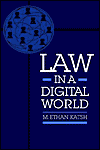This book joins the popular press in perpetuating misconceptions about the Internet.
By Erik J. Heels
First published 10/1/1995; Student Lawyer magazine, “Online” column; publisher: American Bar Association.

With the belief that 1) the Internet is not magical, 2) few (if any) new laws are needed to answer the legal questions it raises, and 3) disaster will not result if the government fails to regulate the Internet, I sat down to read Law in a Digital World by M. Ethan Katsh, Oxford University Press. Law in a Digital World is certainly a thought-provoking book. Many of the topics it covers are important to students and practitioners of the law. But perhaps because of the breadth of the work, the depth of coverage is unsatisfying.
First, Katsh perpetuates the myth of magic. In addition to using many of the buzzwords that make the Internet sound like magic, Katsh even uses the word “magical” to describes how it works. And frequently other terms he employs to describe how the Internet works miss the mark. For example, in a chapter entitled “Communicating In Cyberspace,” Katsh mentions three models of communication, including the one-to-many model (e.g. a personal mailing list), the many-to-many model (e.g. the listserv list), and an online service model (e.g. Lexis or the World-Wide Web). Conspicuously absent from this discussion is the important distinction between centralized methods of communication and publication (typified by listserv lists and FTP servers) and decentralized ones (typified by Usenet newsgroups, Gopher servers, and World-Wide Web servers). Also missing is any discussion of how ISDN technology (which transforms a simple analog phone line into two 64 Kilobyte digital communication channels) blurs the distinction between voice and data networks.
Second, Katsh apparently believes that new laws are necessary to deal with the “problem” of illegal copying on the Internet. As discussed above, it is never necessary or possible to have 100% enforcement of any law, much less copyright law. And the publisher’s copyright page makes the egregious error of misstating the law by failing to account for “fair use” under the Copyright Act. The blanket statement that “no part of this publication may be reproduced in any form” is simply not true.
Katsh’s examples of how the law is “limited” are paralleled by examples of how technology is limited. I argue that the many of the “limitations” are either not limitations at all or are limited by the human factor. For example, Katsh holds out the “talking” dishwasher and the programmable VCR as examples of how modern machines are limited in their capabilities, how they are not linked to each other. He says that it makes no sense to have unconnected machines in a digital world. The same can be said of internal combustion engines, which are very powerful machines that frequently perform a single task, such as powering an automobile or a lawnmower. Task-specific machines (whether their heart is a computer chip or an internal combustion engine) are exactly what consumers want. Why would I want my dishwasher to communicate with my VCR? While I agree that automation can be useful both for automating tasks and (as Katsh points out) for gathering information, I disagree that automation is the solution to every problem. One need look no further than the “modern” airport lavatory to see the utter failure of automation in action. Faucets run when people merely want to comb their hair in front of the mirror, and they shut off when one’s hands are still soapy. Often the choice between hot and cold water has been removed entirely.
As another example, Katsh points out that searching for law by key words (Boolean searching) is not very easy. He suggests that natural language searching may be the solution. Bunk. Natural language searching is no help to a lawyer who cannot spot the legal issue. The human factor, whether in finding the relevant case law or figuring out what it means, will always be the limiting factor.
Third, Katsh restates the myth of disaster, stating that bad things will happen if copyright law is not fixed. This myth appears to have its roots in the writings of John Perry Barlow, one of the founders of the Electronic Frontier Foundation. In the March 1994 issue of Wired, Barlow asked the following question: “If our property can be infinitely reproduced and instantaneously distributed all over the planet without cost, without our knowledge, without is even leaving our possession, how can we protect it?” (The phrase “Doctor, Doctor, it hurts when I do this” quickly comes to mind…) I would answer this question by asking more questions. Why do you feel that protection is necessary? What is the goal of protection?
There is a world of difference between intellectual property (which are usually statutory rights) and its embodiment (e.g. a book, computer file, or painting). But that issue alone can fill a textbook. (For example, see Stevens v. Gladding, 14 How. 528 (1854), where the court held that the purchaser of copper printing plates did not have the right to make maps therefrom.) The legal community must educate legal professionals, consumers, and producers of intellectual property about intellectual property and the law governing it.
Law in a Digital World is a good introduction to the legal and technical challenges facing the legal profession as more and more information becomes available in digital form. But if fails to challenge–and in fact often repeats–many of the assumptions made by the popular press.
“Law in a Digital World” by M. Ethan Katsh.
Summary: two stars (2/5).

